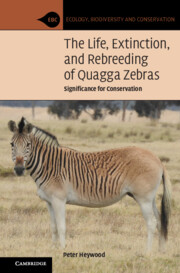
-
Select format
-
- Publisher:
- Cambridge University Press
- Publication date:
- April 2022
- May 2022
- ISBN:
- 9781108917735
- 9781108831604
- 9781108926911
- Dimensions:
- (228 x 152 mm)
- Weight & Pages:
- 0.52kg, 242 Pages
- Dimensions:
- (228 x 152 mm)
- Weight & Pages:
- 0.42kg, 242 Pages
You may already have access via personal or institutional login
Book description
Quaggas were beautiful pony-sized zebras in southern Africa that had fewer stripes on their bodies and legs, and a browner body coloration than other zebras. Indigenous people hunted quaggas, portrayed them in rock art, and told stories about them. Settlers used quaggas to pull wagons and to protect livestock against predators. Taken to Europe, they were admired, exhibited, harnessed to carriages, illustrated by famous artists and written about by scientists. Excessive hunting led to quaggas' extinction in the 1880s but DNA from museum specimens showed rebreeding was feasible and now zebras resembling quaggas live in their former habitats. This rebreeding is compared with other de-extinction and rewilding ventures and its appropriateness discussed against the backdrop of conservation challenges—including those facing other zebras. In an Anthropocene of species extinction, climate change and habitat loss which organisms and habitats should be saved, and should attempts be made to restore extinct species?
Awards
Winner, 2023 Choice Awards
Reviews
‘The book is an enjoyable account of this interesting case of demise and attempted resurrection, and will appeal to conservation scientists as well as wildlife enthusiasts.’
Brian W. van Wilgen Source: South African Journal of Science
‘For those interested in conservation, Africa, and the science of endangered species, this is an excellent short book to get a broad scope of how science has shaped conservation. Animal historians will find this a useful volume for understanding how one esoteric species connects across human cultures and time.’
Amanda Lewis-Nang'ea Source: H-Net Reviews
‘… highly recommended to readers with a conservation background, particularly those who are interested in de-extinction. Animal historians will also find this a fulfilling work, as it is a well-written, compact natural/political history concerning a complex and, largely, novel wildlife issue. There is a lot packed into this short book; however, it stands as a remarkable stroll into the world of a beautiful species, their devastating loss, and our grappling with a world left without.’
Joshua Jones Source: Animal History
Contents
Metrics
Altmetric attention score
Full text views
Full text views help Loading metrics...
Loading metrics...
* Views captured on Cambridge Core between #date#. This data will be updated every 24 hours.
Usage data cannot currently be displayed.
Accessibility standard: Unknown
Why this information is here
This section outlines the accessibility features of this content - including support for screen readers, full keyboard navigation and high-contrast display options. This may not be relevant for you.
Accessibility Information
Accessibility compliance for the PDF of this book is currently unknown and may be updated in the future.

